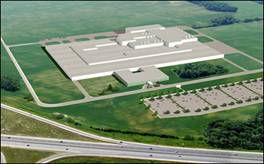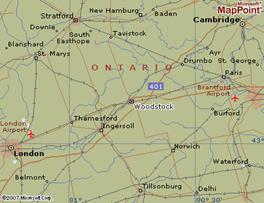|
Group 3: Industrial Transformation in Waterloo
Introducton
Traditionally, Canada had been a manufacturing country which embraced the concept of diversity that a number of manufacturing industries like furniture, textiles to metal work can be found within the region. However, due to economic recession in the 1980’s and early 1990’s, Canada’s manufacturing industry was hit by a huge blow that a large proportion of them leaved Canada for places with lower production costs (Prof. Paul Parker, personal communication, 22 May, 2007). Since then, there was a mushrooming in the development of the high-tech industries based on the comparative advantage concept as the then living standard of Canada can sustain long term growth of this industry. However, high-tech industries rooted in the Canada’s soil as early as the 1960’s when computers were just being developed. And in 1987, Canada’s Technology Triangle, including the city of Waterloo, Kitchener and Cambridge, was set up to promote the cluster of technology development (Prof. Paul Parker, personal communication, 22 May, 2007). Nowadays, more than 400 high tech firms are located in Waterloo, fuelling her economy in an ever growing proportion of added-values (Prof. Paul Parker, personal communication, 22 May, 2007).
|
Waterloo’s Technology Park |
This transformation from a manufacturing economy to a high-tech environment interested us and we spent a day (Prof. Paul Parker, personal communication, 22 May, 2007) visiting places of importance in terms of Canada’s technology development. The schedule for that day’s trip is described below.
In the morning, we took a bus and left the campus of University of Waterloo. We went past one of the famous high-tech firms called Research in Motion, producer of Blackberry wireless platform. Then we arrived at the Waterloo Park and took a view of the Perimeter Institute. After that we went to Kitchener and walked past the School of Pharmacy upon which the new industry of health science is based. We then got to the top floor of the Kitchener City Hall and took a perspective of the whole Kitchener’s urban morphology. Later, in the afternoon, we went to the Toyota Motor Manufacturing Centre (TMMC) in Cambridge and were shown the whole high-tech process of producing automobiles in a chain-car tour. After that, we visited the Accelerator Centre back in the Technology Park of Waterloo and saw the government’s effort in helping nurture high tech industry by smoothing the process of ‘turning an idea into a business.’
In this report, we will first discuss the background of Canada’s industrial transformation and then we will go on to report the data we collected for the two main research places to give an introduction to Toyota Motor Manufacturing Canada and Accelerator Centre at the Technology Park of Waterloo. After that, the social implication of industrial transformation will be examined while the report will end with an evaluation of our project proposal.
|
Background of Industrial Transformation
Waterloo is the smallest city in the Regional Municipality of Waterloo. Regional Municipality of Waterloo is formed by three cities of Cambridge, Kitchener and Waterloo and four rural townships (Prof. Paul Parker, personal communication, 22 May, 2007). People called the three cities as Canadian Technology Triangle since 1987. Canadian Technology Triangle refers to the cooperation of Cambridge, Kitchener and Waterloo developing high technology (Wikipedia, 2007).
  
The Canadian Technology Triangle
Source: http://www.techtriangle.com/ |
|
|
|
Why the industry of Canada had to head towards another direction starting from the 1980’s? It is because along with the development of Waterloo, land rent, wages and raw materials increased and thus the cost of the production (Prof. Paul Parker, personal communication, 22 May, 2007). The traditional industrial factories, without guaranteeing a sustainable profitable margin, they departed from Waterloo and found other places with lower cost of production. This was marked by the huge scale of industrial plants closures and job losses in the early 1980’s (Prof. Paul Parker, personal communication, 22 May, 2007). On the other hand, high tech firms were not affected by the increased land rent so much because they are high value added industry and land utilization is much smaller in scale since they do not need too much space and the profits can cover the total cost of the production.
In addition, the high level education also helps high tech industry in Waterloo a lot. University of Waterloo is ranked at the top of university in Canada. The subject like Engineering, Computer Science and Mathematics in University of Waterloo are famous in the world (Wikipedia, 2007). Therefore, the university provides a lot of high skilled labour for Waterloo every year and it helps the development of high technology a lot in Waterloo.
Nowadays, 400 high tech firms are located in Waterloo and Waterloo has been the second most important industrial city in Canada (Prof. Paul Parker, personal communication, 22 May, 2007). Besides, many high skilled labours are needed in the area. Accelerator Centre is one of the channels of looking for the excellent workers for the high tech firms. Moreover, Toyota Motor Manufacturing Centre is also one of the successful examples with high technology in Waterloo. Thus, Waterloo has become one of the world’s top seven intelligent communities of 2006 and the world’s top intelligent communities 2007 (Intelligent Community Forum, 2007).

Physical Location of the Canadian Technology Triangle
Source: http://www.techtriangle.com/
|
Toyota Motor Manufacturing Canada
Toyota is one of the most famous automobile manufacturing companies in the world. Over the continent of North America, there are 17 manufacturing plants. Its first and only plant in Canada now is called Toyota Motor Manufacturing Canada (TMMC), which is located in Cambridge, Ontario. It was established in Sept 1986. TMMC mainly produces three types of cars, they are Matrix, Lexus RX330 and Corolla (Toyota Motor Sales, U.S.A., Inc., 2007).
The rationale of choosing Cambridge as the location is because of its proximity to the University of Waterloo. TMMC is a magnet that can attract a lot of elites from the university. During summer break, lots of talented graduates are looking for summer jobs and TMMC is a good place for them. Also, according to the educational system of University of Waterloo, students have to work outside school to gain 2-year working experience. TMMC is definitely one of their destinations.

Besides, transportation network is a crucial concern for the plant. TMMC is located near one of the major highways, highway 401 to Detroit. It is more convenient to delivery finished products to the markets.

In 2008, there will be a new manufacturing plant built in Woodstock. It is the second Toyota plant in Canada. The location of the new plant is adjacent to several highways like highway 401 and 403. Moreover, its educated labor pool and proximity to the Cambridge plant (40km away) are also reasons why this location was picked.
During manufacturing, some environmental pollution will be created inevitably, especially for heavy industry. However, Toyota plays an important role on environment conservation. For example, All Toyota Plants in North America are certified by ISO 14001. ISO 14001 is a voluntary standard. With this certification, Toyota plant has to develop its own environmental system and policy for environmental conservation. In TMMC, the average electricity charge is much higher than that of domestic use. It is because it shows the commitment of TMMC in perusing good environment. If TMMC uses a lot of electricity, it has to pay a lot more. Economically, the expenses will increase. So TMMC may find alternative ways to minimize the use of electricity like installing heat recovery units on the paint booth and boiler.
Another example is the way they recycle. TMMC aims for zero landfill by recycling. It is now recycling 99% of the scrap iron, as well as packaging bags, paint solvent and used oil. They also recycle engine blocks that reduce 500,000 pound of them filling up in the landfill site every year.
TMMC also practices alternatives recycling like composting, as well as recycling used water by its water recycling system. Moreover, different kinds of recycling rubbish bins are places inside the plant so that the employers can sort out the waste rather than throwing them in one bin altogether.
Every year, TMMC will provide training to the workers to update and refresh their environmental knowledge and awareness. For example, workers in TMMC need to learn how to treat hazardous disposal and learn environmental management system. Also, they have to take ISO 14001 quizzes twice a year.

|
Accelerator Centre
The acceleratorcentre was opened in May 2006. It is located in the Research & Technology Park, which is very near to the University of Waterloo. It is a not-for-profit corporation, which aims at accelerating innovative venture to commercialize their products or services through the provision of both “hardware” and “software”.
Services
Hardware refers to some facilities and infrastructure, including professional offices suites, basic office furniture, meeting rooms and networking area, etc. Such free provision of hardware can significantly lower the construction cost in the early stage of business operation, thus essential for business starters whose initial capital is usually lacking. The acceleratorcentre goes beyond simply providing hardware; it also involves “software”.

Accelerator Centre
Source: www.acceleratorcentre.com
Software refers to the some business advice, mentoring, administrative support, education programs and networking opportunities, etc. The business advice aims to assist the entrepreneurs to maximize their market potential, and make their incredible ideas a saleable product in the market. On the other hand, the networking opportunities, which is a process attempting to match the innovative talent with the highly effective people and unlimited resources, including finance, HR, design and business planning, etc, is found to be especially useful for the young entrepreneurs as it is often one of the greatest obstacles for the beginners. |
Reference
Intelligent Community Forum. (2007). Top Seven By Year. Retrieved 18th June, from
http://www.intelligentcommunity.org/
Saunders, R. (2003). Defining Vulnerability in the Labor Market. Canada: Canadian Policy Research Networks.
Statistics Canada. (2007). Employment by Industry. Retrieved 29th June, 2007, from http://www40.statcan.ca/l01/cst01/econ40.htm
Statistics Canada. (2007). Canada: Economic and Fianancial Data. Retrieved 29th June, 2007, from http://www40.statcan.ca/l01/cst01/econ40.htm
Maxwell, J. (2003). The Great Social Transformation: Implications for the Social
Role of Government in Ontario. Ottawa: Canadian Policy Research Networks.
Toyota Motor Sales, U.S.A., Inc.. (2007). Environment. Retrieved 4th July, 2007,
from http://www.toyota.com/about/environment/index.html
Toyota Motor Sales, U.S.A., Inc.. (2007). Environment Awards for Toyota. Retrieved
4th July, 2007, from http://www.toyota.com/about/environment/awards/index.html
Wikipedia. (2007). Waterloo, Ontario. Retrieved 26th June, 2007, from
http://en.wikipedia.org/w/index.php?title=Waterloo%2C_Ontario&oldid=140626992
|
|